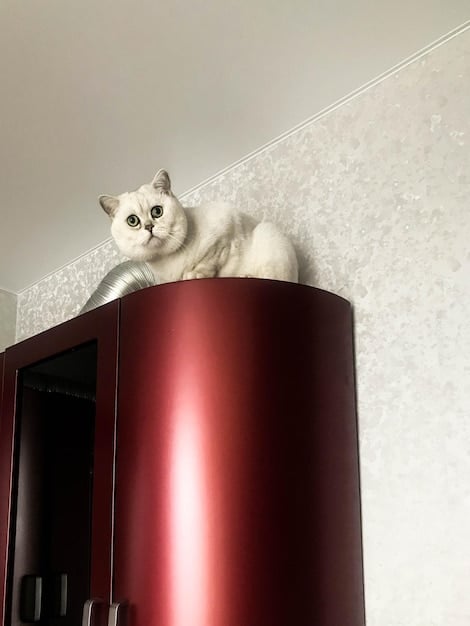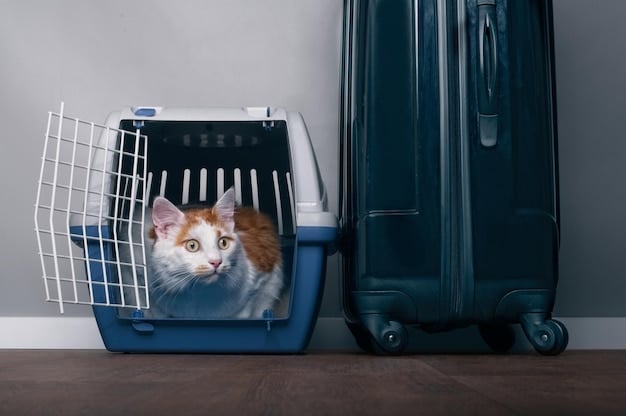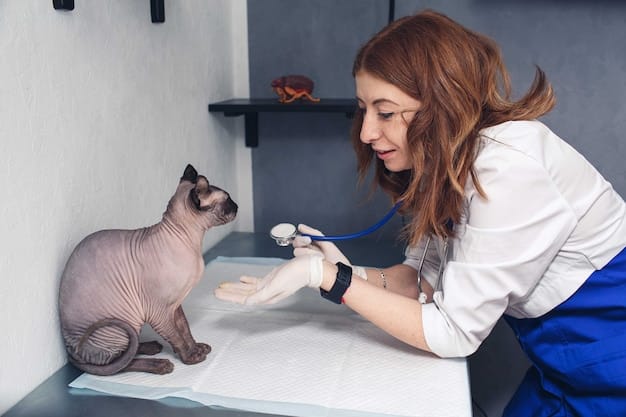Stop Cat Spraying: Causes, Solutions & Training Tips

Stopping your cat from spraying involves understanding the underlying causes, such as stress or territorial marking, and implementing consistent training and environmental modifications to discourage the behavior.
Is your feline friend marking its territory indoors? Stop your cat from spraying: understanding the cause and implementing training solutions is crucial for maintaining a clean and stress-free home. Let’s explore the reasons behind this behavior and how to address it effectively.
Understanding Why Cats Spray
Cat spraying is a common issue for many pet owners. Understanding why cats engage in this behavior is the first step toward finding a solution. It’s not always a sign of disobedience but often a communication method or a response to environmental factors.
Spraying differs from urination in that it’s a deliberate act of marking territory. Cats will typically stand, lift their tail, and release a small amount of urine onto a vertical surface.
Territorial Marking
One of the primary reasons cats spray is to mark their territory. This behavior is more common in multi-cat households or when there are outdoor cats visible.
- Scent glands in their paws and cheeks also contribute to marking, but spraying is a more pronounced declaration of ownership.
- Cats may spray to establish boundaries and reduce anxiety in their perceived territory.
- The scent left behind acts as a message to other cats, signaling presence and dominance.
Stress and Anxiety
Changes in a cat’s environment can trigger spraying. Stressors such as moving to a new home, introducing new pets, or changes in household routines can cause anxiety, leading to spraying.

In conclusion, understanding the underlying cause of your cat’s spraying behavior is essential for implementing effective solutions. Whether it’s territorial marking or stress-induced, identifying the trigger is the first step toward addressing the issue and improving your cat’s well-being.
Identifying the Triggers for Spraying
To effectively address spraying, you need to become a detective and identify the specific triggers. Keeping a detailed record of when and where spraying occurs can provide valuable insights.
Consider all recent changes in the cat’s environment, routine, and interactions. These changes might be the key to stopping the behavior.
Environmental Changes
Pay close attention to any changes within your home or immediate surroundings. New furniture, renovations, or even a new houseplant can affect your cat.
- Construction or landscaping in the neighborhood can also cause stress and trigger spraying.
- Reflected images of outdoor cats in windows can make the cat think they are intruding.
- Moving furniture may make the cat feel like its safety and comfort is taken away.
Social Interactions
The presence of other animals, both inside and outside, is also a significant factor. Monitor how your cat interacts with other pets in the household and any outdoor cats they can see.
In conclusion, identifying the triggers for spraying requires careful observation and a thorough understanding of your cat’s environment and social interactions. By pinpointing the specific stressors, you can create a more stable and secure environment, reducing the likelihood of spraying.
Medical Reasons to Consider
Before assuming that spraying is purely behavioral, it’s crucial to rule out any underlying medical conditions. Urinary issues, for example, can sometimes mimic spraying.
Consult with your veterinarian to perform a thorough check-up. Ruling out medical causes will help you focus on behavioral solutions.
Urinary Tract Infections
Urinary tract infections (UTIs) can cause discomfort and changes in urination habits. This discomfort may lead cats to associate the litter box with pain, causing them to urinate elsewhere.
- Symptoms of UTIs include frequent attempts to urinate, straining, and blood in the urine.
- A vet can diagnose a UTI with a urine sample and prescribe antibiotics to treat the infection.
- It’s essential to differentiate between spraying and UTI-related urination, as the solutions differ significantly.
Bladder Stones
Bladder stones can cause pain and irritation, leading to changes in urination behavior. These stones can obstruct the urinary tract, making urination difficult and painful.

In conclusion, it’s vitally important to consider medical reasons behind spraying. By consulting with a vet and ruling out potential health issues, you can ensure that your cat receives the appropriate care and treatment.
Cleaning Up Existing Spray Marks
Effectively cleaning up spray marks is essential for preventing repeat offenses. Cats have a keen sense of smell, and lingering odors can attract them back to the same spot.
Use enzymatic cleaners specifically designed to eliminate cat urine odors. These cleaners break down the organic compounds in the urine, removing the scent at its source.
Enzymatic Cleaners
Enzymatic cleaners are far more effective than regular household cleaners. They contain enzymes that digest the bacteria in cat urine, eliminating the odor completely.
- Follow the product instructions carefully, as some cleaners require a specific dwell time to work effectively.
- Test the cleaner on an inconspicuous area first to ensure it doesn’t damage the surface.
- Avoid using cleaners containing ammonia, as this scent can mimic urine and encourage further spraying.
Proper Cleaning Techniques
Ensure you thoroughly saturate the affected area with the enzymatic cleaner. Blot the area dry instead of wiping, as wiping can spread the urine.
In conclusion, cleaning spray marks effectively is a crucial step in preventing repeat spraying. Using enzymatic cleaners and proper cleaning techniques will eliminate odors at their source, discouraging your cat from marking the same areas again.
Implementing Training Solutions
Training is a key component of stopping cat spraying. Combine behavioral techniques with environmental modifications to address the underlying causes and discourage the behavior.
Consistency is crucial. Ensure all members of the household are on board with the training strategies and maintain a consistent approach.
Positive Reinforcement
Reward your cat when they exhibit desired behaviors, such as using the litter box or interacting calmly with other pets. Positive reinforcement helps create positive associations and encourages good behavior.
- Use treats, praise, or affection to reward your cat immediately after they use the litter box.
- Avoid punishing your cat for spraying, as this can increase anxiety and worsen the problem.
- Provide plenty of toys and playtime to keep your cat entertained and reduce boredom-related spraying.
Litter Box Management
Ensure your cat has access to clean and accessible litter boxes. The number of boxes, their location, and the type of litter can all affect a cat’s litter box habits.
In conclusion, implementing effective training solutions requires a combination of behavioral techniques and environmental modifications. By rewarding desired behaviors, managing litter box habits, and using deterrents, you can discourage spraying and create a more harmonious environment for your cat.
Environmental Modifications and Enrichment
Modifying your cat’s environment and providing enrichment can significantly reduce stress and anxiety, ultimately decreasing the likelihood of spraying. These changes should focus on creating a secure and stimulating environment.
Ensure your cat has plenty of opportunities for play, exploration, and relaxation. A happy and enriched cat is less likely to engage in unwanted behaviors.
Creating Safe Spaces
Provide multiple safe spaces where your cat can retreat and feel secure. These spaces can include cat trees, cozy beds, or quiet corners.
- Ensure these safe spaces are easily accessible and free from disturbances.
- Adding pheromone diffusers can help create a calming atmosphere.
- Vertical space, such as cat trees, allows cats to observe their surroundings and feel more in control.
Interactive Play
Engage your cat in regular interactive play sessions. Play helps reduce stress, provides exercise, and strengthens the bond between you and your cat.
In conclusion, environmental modifications and enrichment are essential components of preventing cat spraying. By creating safe spaces, engaging in interactive play, and addressing territorial concerns, you can reduce your cat’s stress and anxiety, leading to a significant decrease in spraying behavior.
| Key Point | Brief Description |
|---|---|
| 🔍 Identify Triggers | Determine the cause of spraying, such as stress or territorial issues. |
| 🩺 Rule Out Medical Issues | Consult a vet to check for UTIs or bladder stones. |
| 🧼 Clean Effectively | Use enzymatic cleaners to eliminate urine odors completely. |
| 🏡 Modify Environment | Provide safe spaces and enrichment to reduce stress. |
FAQ
▼
Neutered cats may spray due to territorial instincts, stress, or underlying medical issues. Consider environmental changes or anxiety triggers. Consult a vet to eliminate health concerns and adjust home environment.
▼
Spraying involves a small amount of urine on vertical surfaces, while urination issues include larger amounts deposited normally. Look for differences in posture, quantity, and location to distinguish.
▼
Yes, pheromone diffusers and sprays can reduce anxiety. SentryStop works. Also, motion-activated sprays can deter cats from specific locations. Always test new products in small areas carefully.
▼
The time varies depending on the cause and consistency of interventions. Some issues resolve within weeks, while others require months. Be patient and persistent with your approach.
▼
If the spraying persists, consider seeking help. A veterinarian can look for medical issues. A behaviorist will suggest training techniques. Don’t hesitate to seek professional assistance.
Conclusion
Stopping cat spraying requires patience, understanding, and a multi-faceted approach. By identifying the underlying causes—whether they be medical, environmental, or behavioral—and implementing targeted solutions, you can effectively address the issue and create a more harmonious living environment for both you and your feline companion. Consistency, attentiveness, and a commitment to your cat’s well-being are key to achieving long-term success in managing and eliminating this challenging behavior.





